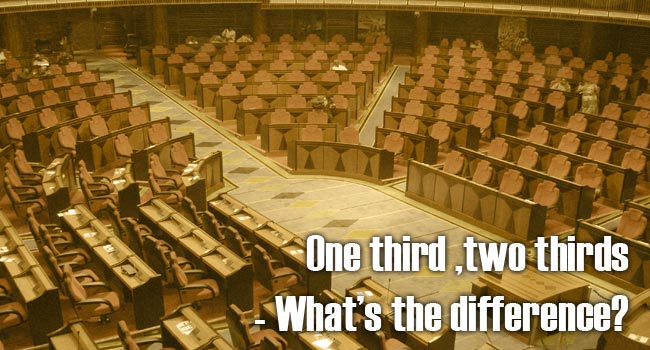One-third, two-thirds what is the difference?

By Joy Mdivo
I have had a very interesting and eye opening experience today. In Kenya, there is the case currently in Court about the nominations to the brand new never been seen before in Kenya Supreme Court. For the benefit of those who do not know what this is, let me break this down for you. We passed a new Constitution last year that stipulated in it that the composition of all elective and appointive bodies will have to have no more than two thirds of one gender. The Supreme Court nominations have Two Women and Five Men. Has the requirement to not have more than two thirds of one gender been met? Lawyer Judy Thongori counsel for women lobby groups, who challenged the nomination of five Supreme Court judges on grounds that their nomination did not reflect gender balance.
The Federation of Women Lawyers Kenya Chapter (FIDA-Kenya) has led a group of several women's organizations to challenge this balance as failing to meet the Constitutional provisions. The Chief Justice has appointed some reputable Human rights lawyers to defend the Judicial Service Commission in the matter. Till now, I was a casual observer to this circus, since as you can tell from my earlier posts, my beef with the JSC was on a different tangent, but today they are not lucky, I am on their back again!
Let us do the math. Two thirds of 7 will give you 4.67 people. One third will give you 2.33. Now we know there are no .33 people (duh!) so how do we resolve the impasse? Article 81(2) of the Constitution of Kenya 2010 reads as follows.
81. The electoral system shall comply with the following principles––
(b) not more than two-thirds of the members of elective public bodies shall be of the same gender;
This means any number less than or equal to two thirds is within the Constitutional confines. It therefore follows, any such overflow, must be rounded down to ensure the threshold is met. This means therefore if you have 4.67 rounded off to 5 people, 5 is more than the two thirds MAXIMUM and therefore it cannot be Constitutional. Meaning, .67 takes it over and above and therefore is unconstitutional. The only solution is to round it off to 4 so that the number of the opposite gender comes up to 3 meeting the threshold of NOT MORE THAN two thirds.
The argument has been on women attaining the one third threshold, but that premise is misleading. The constitution gives the maximum, and it cannot be exceeded even by one person. Not getting it yet? Let me try it another way. Having 5 members of one gender in a 7 member Court translates to 71.43% of the court being represented by one gender. Having 2 members of one gender in a 7 member Court translates to 28.57%. Two thirds would be 66.67%, meaning the current composition of the Supreme Court is 4.76% OVER the allowed constitutional maximum. This may seem like a small difference but just think of it this way. We are to have a National Assembly with 350 members. If it were to be 4.76% off, instead of having 233.33 members of one gender topping the two thirds maximum, you would have 16.6 more members, making the new number 250. That is 17 members over the limit, but the same 4.76%
I know either you have a eureka moment, or you are shaking your head wondering what I am on about. The moral of this whole story is this. The Supreme Court appointments may look like the are off not even by a whole person, so why the big deal. Think of a protractor, where you measure one degree from another is a single convergent point, but as the lines elongate, it becomes apparent that a degree from another travel very different paths and if you meet them after one kilometre, they will be so far apart. A builder puts a plumbline to determine whether a wall is straight, because even the smallest deviation, could see the whole structure collapse. If we are implementing this constitution, lets do it right, otherwise, in future the mess will be bigger than we could have imagined, and may be too late for us to fix. God bless y'all.
Get more of Joy's Musings at joymdivo.blogspot.com


